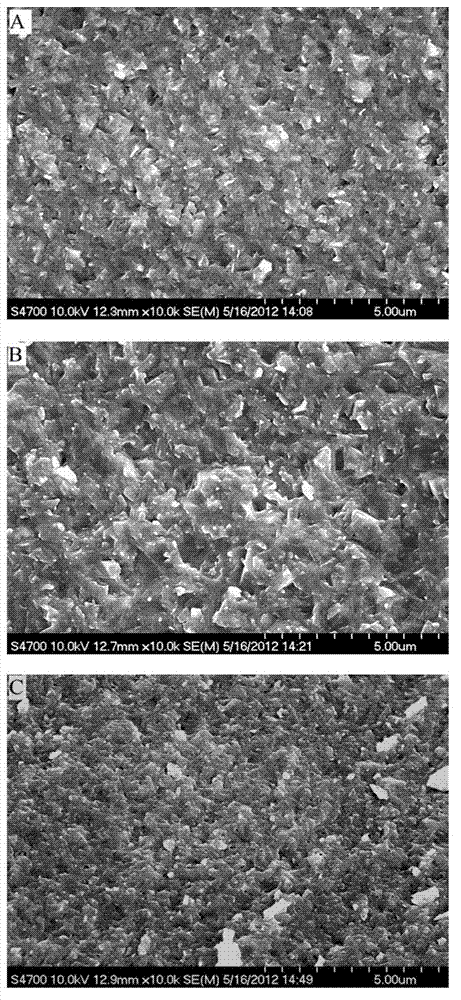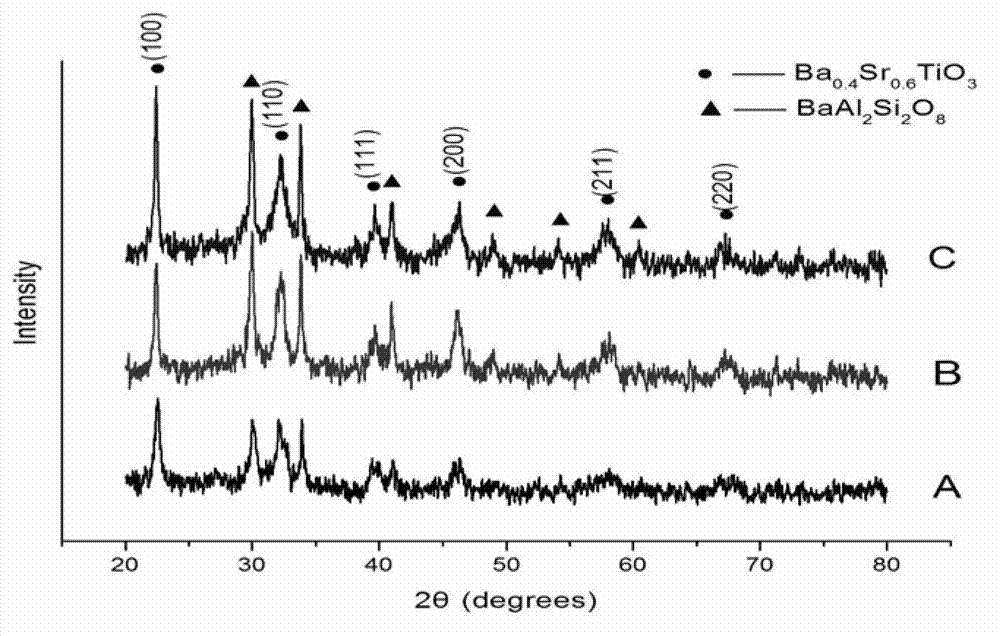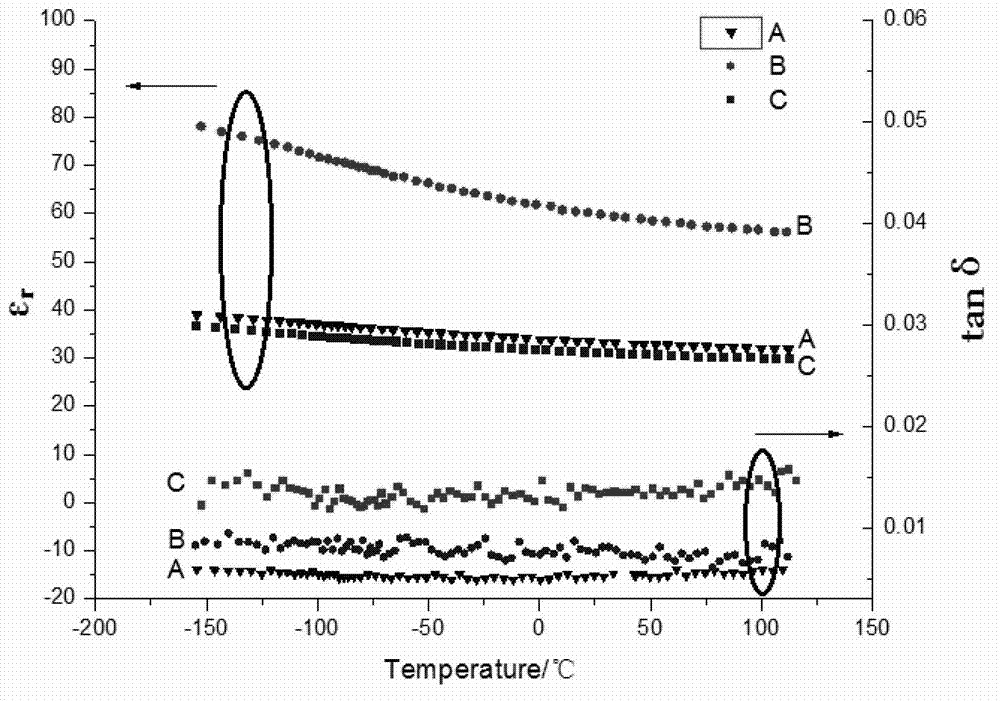Preparation method of barium strontium titanate based glass ceramic energy storage material
A technology of glass ceramics and barium strontium titanate, which is applied in glass production, components of fixed capacitors, and dielectrics of fixed capacitors, etc., and can solve problems such as increased connection loss
- Summary
- Abstract
- Description
- Claims
- Application Information
AI Technical Summary
Problems solved by technology
Method used
Image
Examples
Embodiment 1
[0030] Prepare a barium strontium titanate-based glass-ceramic material as follows:
[0031] 1) BaCO with a purity greater than 99wt% 3 , SrCO 3 、TiO 2 , SiO 2 、Al 2 o 3 As raw material ingredients, the molar percentage of each component is 14.8%, 22.2%, 29%, 12%, 22%, after mixing by ball mill for 20h, drying, and melting at 1550℃ for 3.5h;
[0032] 2) Pouring the high-temperature melt obtained in step 1 into a metal mold, annealing for stress relief at 700°C for 4 hours, and then cutting to obtain glass flakes with a thickness of 0.5mm;
[0033] 3) The glass flakes prepared in step 2 were kept in a conventional furnace at a temperature of 950° C. for 2 hours for controlled crystallization to obtain glass ceramics.
[0034] The SEM collection of illustrative plates of the ceramic sample that the present embodiment makes is as figure 1 As shown, the XRD pattern is as figure 2 As shown, the dielectric properties and withstand voltage properties are as image 3 , 4 sh...
Embodiment 2
[0036] Prepare a barium strontium titanate-based glass-ceramic material as follows:
[0037] 1) BaCO with a purity greater than 99wt% 3 , SrCO 3 、TiO 2 , SiO 2 、Al 2 o 3 As raw material ingredients, the molar percentage of each component is 14.8%, 22.2%, 29%, 12%, 22%, after mixing by ball mill for 20h, drying, and melting at 1550℃ for 3.5h;
[0038] 2) Pouring the high-temperature melt obtained in step 1 into a metal mold, annealing for stress relief at 700°C for 4 hours, and then cutting to obtain glass flakes with a thickness of 0.5mm;
[0039] 3) The glass flakes prepared in step 2 were kept in a microwave oven at a temperature of 950° C. for 10 minutes for controlled crystallization to obtain glass ceramics.
[0040] The SEM collection of illustrative plates of the ceramic sample that the present embodiment makes is as figure 1 As shown, the XRD pattern is as figure 2 As shown, the dielectric properties and withstand voltage properties are as image 3 , 4 shown...
Embodiment 3
[0042] Prepare a barium strontium titanate-based glass-ceramic material as follows:
[0043] 1) BaCO with a purity greater than 99wt% 3 , SrCO 3 、TiO 2 , SiO 2 、Al 2 o 3 As raw material ingredients, the molar percentage of each component is 14.8%, 22.2%, 29%, 12%, 22%, after mixing by ball mill for 20h, drying, and melting at 1550℃ for 3.5h;
[0044] 2) Pouring the high-temperature melt obtained in step 1 into a metal mold, annealing for stress relief at 700°C for 4 hours, and then cutting to obtain glass flakes with a thickness of 0.5mm;
[0045] 3) Keep the glass flakes prepared in step 2 in a conventional furnace at 950°C for 2 hours for controlled crystallization to obtain glass ceramics;
[0046] 4) Heat the glass-ceramics obtained in step 3 in a microwave oven at a speed of 30°C / min to 950°C for 2 minutes, and perform microwave heat treatment to obtain a glass-ceramic dielectric with high energy storage density.
[0047] The SEM collection of illustrative plates o...
PUM
| Property | Measurement | Unit |
|---|---|---|
| Thickness | aaaaa | aaaaa |
| Thickness | aaaaa | aaaaa |
| Thickness | aaaaa | aaaaa |
Abstract
Description
Claims
Application Information
 Login to View More
Login to View More - R&D Engineer
- R&D Manager
- IP Professional
- Industry Leading Data Capabilities
- Powerful AI technology
- Patent DNA Extraction
Browse by: Latest US Patents, China's latest patents, Technical Efficacy Thesaurus, Application Domain, Technology Topic, Popular Technical Reports.
© 2024 PatSnap. All rights reserved.Legal|Privacy policy|Modern Slavery Act Transparency Statement|Sitemap|About US| Contact US: help@patsnap.com










